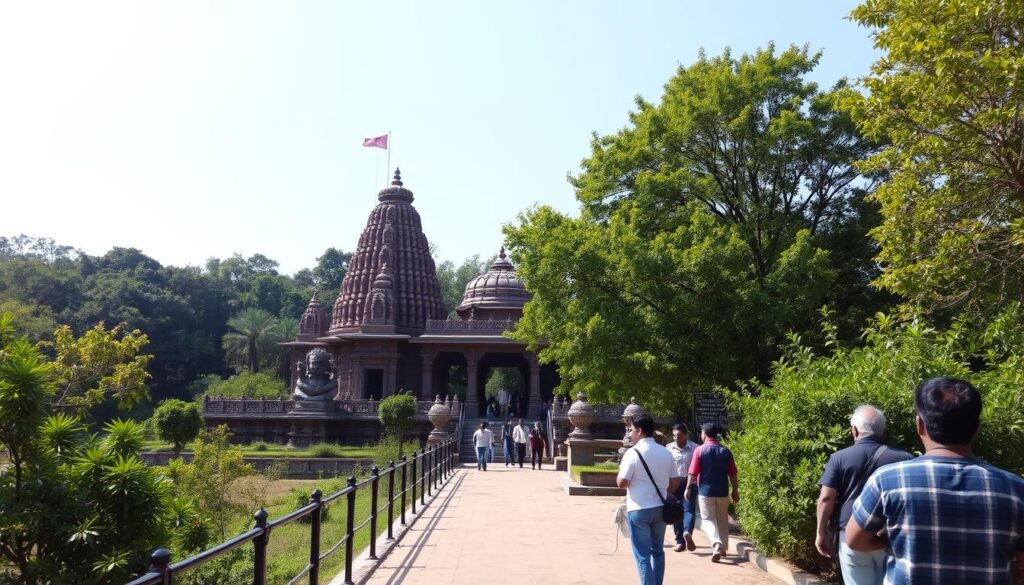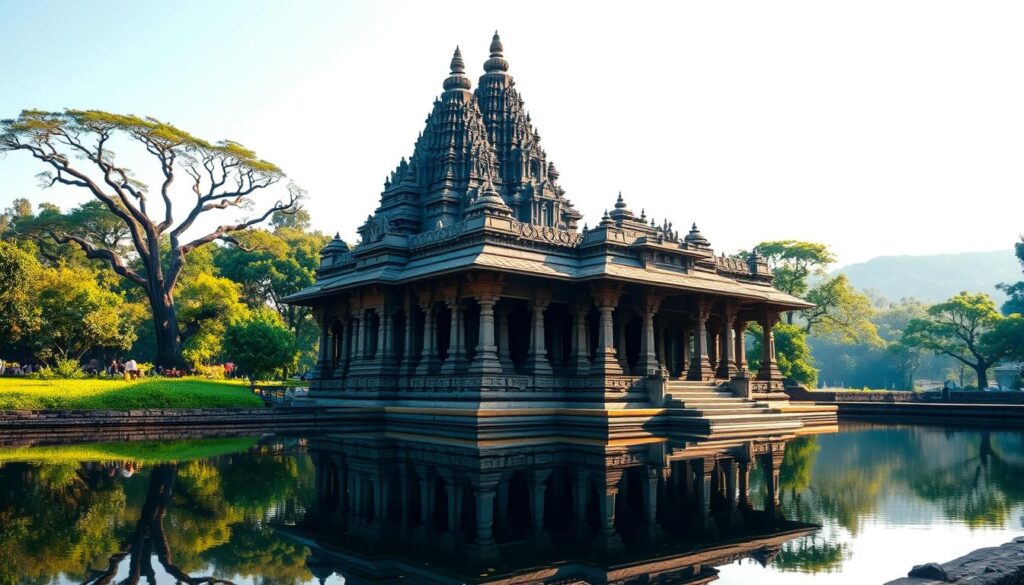The Mukteswara Temple is a stunning example of Indian architecture. It showcases the Kalinga style, making it a must-see for history buffs and temple enthusiasts.
This ancient temple is adorned with intricate stone carvings and beautiful sculptures. It’s a true masterpiece of Indian architecture. It reflects the rich cultural heritage of the region and perfectly represents the Kalinga style.
Indian architecture has a unique way of captivating its audience. The Mukteswara Temple is no exception. Its breathtaking designs and patterns show the skill and craftsmanship of the artisans who built these ancient temples.
The Mukteswara Temple is an exemplary model of ancient Indian architecture. Its Kalinga style is a significant part of India’s cultural heritage. It’s a fascinating destination for anyone interested in exploring the history and culture of the region.
The Historical Legacy of Mukteswara Temple
The Mukteswara Temple is famous for its historical legacy that goes back over a thousand years. It’s a key part of Indian history. This ancient temple shows India’s skill in building and its cultural wealth. It draws people from all over who love history and architecture.
In the heart of India, the Mukteswara Temple highlights the country’s varied cultures and buildings. Its detailed carvings, sculptures, and beautiful design make it a top spot for history and temple lovers. The temple’s historical legacy mirrors the area’s deep cultural heritage, shaped by many dynasties and empires.
The Mukteswara Temple is more than its amazing architecture and historical legacy. It’s also a key pilgrimage site, drawing visitors from everywhere. The temple’s detailed carvings and sculptures show the talent of the artisans who made it. Exploring the Mukteswara Temple helps visitors understand Indian history and the country’s rich culture.
Architectural Marvel: The Gem of Kalinga Style
The Mukteswara Temple is famous for its stunning Kalinga style. This style is known for its elegance and simplicity. It combines Hindu and Buddhist elements, making it unique.
The temple’s design is full of intricate stone carvings and beautiful sculptures. These show the skill of the artisans who made it.
The Kalinga style is known for its detailed carvings and sculptures. The Mukteswara Temple is a great example, with its walls and pillars covered in carvings. These depict gods, goddesses, and mythological figures.
This style is a big part of Indian architecture. The Mukteswara Temple is one of the most famous examples.
The Kalinga style has greatly influenced Indian architecture. Many temples and monuments show its unique features. The Mukteswara Temple is a lasting legacy of this style, inspiring wonder in all who see it.
| Characteristics | Kalinga Style | Indian Architecture |
|---|---|---|
| Intricate Carvings | Yes | Varies |
| Simplicity and Elegance | Yes | Depends on the style |
| Blend of Hindu and Buddhist Influences | Yes | Not always |
The Mukteswara Temple is a top example of the Kalinga style. Its architecture shows the region’s rich culture. This style continues to inspire and influence architecture in India.
Sacred Symbolism and Religious Significance
The Mukteswara Temple is a sacred site, holding great religious significance for Hindus. Its architecture and design are filled with sacred symbolism. This reflects the rich cultural and spiritual heritage of India.
In Hinduism, the temple is seen as a bridge between the divine and human worlds. The temple’s dedication to Lord Shiva makes it a major pilgrimage site in India. The sacred symbolism in its design and architecture reminds us of the importance of spirituality and faith in Hinduism.
The intricate carvings and sculptures throughout the temple complex show the skill and craftsmanship of the artisans. At the heart of the temple’s symbolism is the concept of liberation. This concept is deeply rooted in Hinduism.
The temple’s design and architecture are meant to guide devotees on their spiritual journey. They help devotees understand themselves and the world better.
| Aspect of the Temple | Symbolic Meaning |
|---|---|
| Dedication to Lord Shiva | Connection between the divine and human worlds |
| Intricate carvings and sculptures | Skill and craftsmanship of the artisans |
| Concept of liberation | Guiding devotees on their spiritual journey |
Intricate Stone Carvings and Sculptural Wonders
The Mukteswara Temple is a true masterpiece of Indian art. It’s famous for its detailed stone carvings and sculptural wonders. The walls and pillars are covered in beautiful artwork, showing the talent of Indian artisans.
These carvings tell stories from mythology, making the temple even more stunning. They highlight the temple’s beauty and importance.
The temple’s sculptures are a marvel of ancient craftsmanship. The artisans’ skill is evident in every detail. Each carving is a work of art, full of intricate designs and patterns.

Visiting the temple is a unique experience. You’re surrounded by the grandeur of Indian art. The carvings’ precision and detail show the artisans’ incredible skill.
This makes the Mukteswara Temple a must-see for anyone interested in Indian art and culture.
Understanding the Temple Complex Layout
The Mukteswara Temple complex is a stunning example of Indian architecture. It showcases the Kalinga style with a unique layout. The design features interconnected buildings and courtyards, creating harmony and balance.
This layout helps devotees and pilgrims move smoothly. It offers a peaceful atmosphere for worship and contemplation.
The temple complex is a self-contained unit. It has all the facilities needed for religious and cultural activities. The layout ensures harmony among the main temple, courtyards, and surrounding buildings.
This design is a hallmark of Indian architecture. The Mukteswara Temple complex is a prime example.
The space and arrangement of the temple complex aim for balance and proportion. It also allows for the movement of many people. Yet, it keeps quiet spaces for contemplation and worship.
The Mukteswara Temple complex shows the skill of its architects and builders. It is a magnificent example of Indian architecture.
The Art and Aesthetics of Mukteswara Temple
The Mukteswara Temple is famous for its stunning art and design. It shows the deep cultural roots of the area. The temple’s mix of Hindu and Buddhist styles is a marvel of Indian craftsmanship.
The temple’s walls and pillars are covered in detailed carvings. These carvings tell stories from Hindu myths and everyday life. The use of stone and wood makes the temple even more beautiful.
The temple’s art and design have been kept safe for centuries. They have shaped Indian art and design. Today, they still inspire many artists and designers.
The following table highlights the key features of Mukteswara Temple’s art and aesthetics:
| Feature | Description |
|---|---|
| Intricate stone carvings | Delicate and intricate designs depicting scenes from Hindu mythology and everyday life |
| Sculptural wonders | Exquisite sculptures of Hindu deities and mythological figures |
| Natural materials | Use of stone and wood adds to the temple’s cultural significance and aesthetic appeal |
The art and design of Mukteswara Temple showcase India’s rich culture. It’s a place everyone interested in Indian art and culture should see.
Festivals and Celebrations at the Temple
The Mukteswara Temple is a lively cultural center, hosting many festivals and celebrations all year. It’s a key pilgrimage site, drawing people from everywhere. This shows India’s rich cultural scene.
At the temple, you can see traditional dances and hear live music. These events are a big part of the temple’s cultural scene. They bring people together and create a sense of community. The temple’s beauty makes it a great place for these events.
Visitors flock to the temple to see India’s unique cultural scene. Its history and architecture make it a top spot for exploring. Whether you’re a believer or just curious, the temple’s cultural scene will give you memories to cherish.
Planning Your Visit
When planning a visit to the Mukteswara Temple, it’s key to know the temple’s rules and local customs. The temple welcomes visitors all year, making it a great spot for tourism. There are many places to stay nearby, so you can find something that fits your needs.
Think about getting a guide or joining a tour to learn more about the temple. This will help you understand its history, architecture, and importance. Remember, the temple is sacred, so dress modestly and respect local traditions.
For more on the temple’s history and importance, check out the temple’s website. It has tips on planning your visit and what to expect. Also, tourism websites offer guided tours and itineraries for the temple and nearby areas.

By planning well and learning about the temple, you’ll have a great time. Whether you love history, architecture, or local culture, the Mukteswara Temple is a must-see. It’s perfect for anyone interested in tourism and cultural exploration.
| Accommodation Options | Guided Tours | Temple Rules and Regulations |
|---|---|---|
| Hotels, guesthouses, and hostels | Available in multiple languages | Dress modestly, respect local customs |
| Range of prices and amenities | Include temple history and significance | Remove shoes before entering the temple |
Conservation Efforts and Restoration Projects
The Mukteswara Temple is a protected monument. It’s getting a lot of conservation and restoration work to keep its heritage alive. The temple’s detailed stone carvings and sculptures are a big challenge to restore.
Experts like architects, engineers, and artisans are teaming up to fix the temple. They want to keep the temple’s heritage alive. They’re working hard to make sure it stays a symbol of India’s architectural greatness.
The conservation work at the Mukteswara Temple shows how vital it is to save our cultural heritage. By bringing the temple back to its former beauty, we help future generations enjoy its beauty and history. The restoration efforts are key to keeping our shared heritage alive and spreading cultural awareness.
A Living Testament to India’s Architectural Heritage
The Mukteswara Temple is a living testament to India’s rich architectural heritage. It stands as a timeless reminder of the country’s diverse cultural and artistic traditions. It inspires awe and wonder in all who visit.
Visitors are transported to a bygone era when they explore the intricate stone carvings and sculptural wonders. The temple showcases the craftsmanship and ingenuity of the Kalinga style. It continues to captivate and inspire people from all over the world, highlighting India’s global leadership in architectural heritage.
The temple’s preservation and restoration efforts show the Indian people’s commitment to their cultural legacy. As the Mukteswara Temple stands tall, it reminds us of the timeless beauty and enduring significance of India’s architectural heritage.


